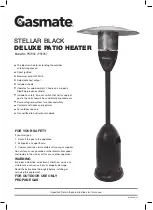
28
figure 26.
If the Temperature-Pressure relief Valve on the water heater
weeps or discharges periodically, this may be due to thermal
expansion.
NoTe: excessive water pressure is the most common cause of
Temperature-Pressure relief Valve leakage. excessive water
system pressure is most often caused by "thermal expansion"
in a "closed system." See Closed Water Systems and Thermal
expansion on page 12. The Temperature-Pressure relief Valve
is not intended for the constant relief of thermal expansion.
Temperature-Pressure relief Valve leakage due to pressure
build up in a closed system that does not have a thermal
expansion tank installed is not covered under the limited
warranty. Thermal expansion tanks must be installed on all
closed water systems.
Do NoT PLug THe TemPerATure-PreSSure reLIef
VALVe oPeNINg. THIS CAN CAuSe ProPerTY DAmAge,
SerIouS INJurY or DeATH.
Explosion Hazard
Temperature-Pressure Relief Valve
must comply with ANSI Z21.22-
CSA 4.4 and ASME code.
Properly sized temperature-
pressure relief valve must be
installed in opening provided.
Can result in overheating and
excessive tank pressure.
Can cause serious injury or death.
hot water odor
on occasion, hot water may develop a strong odor. If this occurs
drain the heater completely, flush thoroughly, and refill. If the
problem persists, chlorination of the heater and replacement
of magnesium anodes with aluminum anodes may correct the
condition.
occasionally water softener companies recommend removal of
heater anodes for odor reasons.
unauthorized removal of the anode(s) will void the warranty. for
further information contact your dealer.
Venting system
examine the venting system every six months for obstructions
and/or deterioration of the vent piping.
remove all soot or other obstructions from chimney which will
retard free draft.
remote storage tank temperature control
The water temperature in the remote storage tank (if used) is
controlled by the storage tank temperature control. The sensing
element is mounted in the hot water storage tank, see Water
Piping Diagram section.
A change in water temperature in the storage tank lower than
the tank temperature control setting will cause the sensor to
activate the circulating pump. The pump then circulates the
water through the heater where the thermostat senses the drop
in water temperature and activates main burner operation of the
appliance.
If the storage tank temperature control is out of calibration, replace
with new control.
SHouLD oVerHeATINg oCCur or THe gAS SuPPLY fAIL
To SHuT off, TurN off THe mANuAL gAS CoNTroL VALVe
To THe APPLIANCe.
temperature-pressure relief ValVe test
Burn hazard.
Hot water discharge.
Keep clear of Temperature-
Pressure Relief Valve
discharge outlet.
It is recommended that the Temperature-Pressure relief Valve
should be checked to ensure that it is in operating condition every
6 months.
When checking the Temperature-Pressure relief Valve operation,
make sure that (1) no one is in front of or around the outlet of the
Temperature-Pressure relief Valve discharge line, and (2) that
the water discharge will not cause any property damage, as the
water may be extremely hot. use care when operating valve as
the valve may be hot.
To check the relief valve, lift the lever at the end of the valve
several times, see figure 26. The valve should seat properly and
operate freely.
If after manually operating the valve, it fails to completely reset and
continues to release water, immediately close the cold water inlet
to the water heater and drain the water heater, see Draining And
flushing on page 28. replace the Temperature-Pressure relief
Valve with a properly rated/sized new one, see Temperature-
Pressure relief Valve on pages 12-13 for instructions on
replacement.
maintenance
Содержание N71120NE
Страница 25: ...25 LIGHTING OPERATION LABEL FIGURE 22...
Страница 51: ...notes 51...
Страница 52: ...notes 52...
Страница 53: ...notes 53...
Страница 54: ...notes 54...
















































